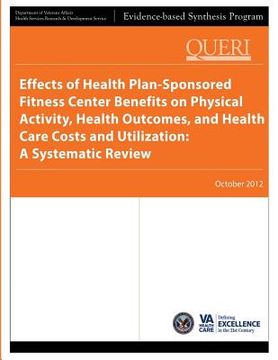Effects of Health Plan-Sponsored Fitness Center Benefits on Physical Activity, Health Outcomes, and Health Care Costs and Utilization: A Systematic Re (en Inglés)
Reseña del libro "Effects of Health Plan-Sponsored Fitness Center Benefits on Physical Activity, Health Outcomes, and Health Care Costs and Utilization: A Systematic Re (en Inglés)"
Regular physical activity has many positive health benefits, including protection against chronic disease, improved physical and mental health and cognitive function, and better health-related related quality of life. Moreover, lack of physical activity is associated with higher health care costs and utilization. The current U.S. guidelines recommend that adult Americans (1) engage in at least 150 minutes of moderate-intensity aerobic activity or 75 minutes of vigorous-intensity aerobic activity each week (or an equivalent mix of moderate- and vigorous-intensity aerobic activity) and (2) perform strengthening activities that target all major muscle groups on at least 2 days a week. However, many Americans do not get the recommended levels of physical activity. More Veterans are sufficiently active than non-Veterans. However, Veterans who use Veterans Affairs (VA) health care are more likely to be physically inactive (22.6% vs. 14.9%) and are less likely to meet physical activity recommendations (42.6% vs. 46.7%) compared with Veterans who do not use VA health care. Multiple personal, social, and environmental factors influence a person's participation in physical activity. Consequently, multiple internal and external barriers to obtaining regular physical activity exist. Internal barriers include a lack of time and motivation, health problems, and emotional difficulties. External barriers involve weather; cultural issues; safety concerns; limited access to facilities, equipment, and transportation; and monetary expenses such as those associated with attending a fitness center. The perceived cost of engaging in physical activity is a significant barrier that increases the likelihood of sedentary behaviors and decreases the likelihood of participation in vigorous physical activity. Thus, reducing the cost of being physically active through providing full or partial memberships to fitness centers may be a viable option to increase physical activity and the positive health outcomes associated with such activity. Given that most Americans (84%) have access to some form of health insurance, health plan promotion of and coverage for fitness center memberships has the potential to address multiple barriers to physical activity (e.g., cost, access) and extend fitness center access to many Americans. The effects of physical activity on health care utilization and costs, various health outcomes, and general well-being are well established. However, the evidence base on health plan-sponsored benefits-specifically involving fitness center memberships-that support these outcomes has not been synthesized. Our objective in this evidence synthesis was to summarize the results of diverse studies of health plan-sponsored fitness center memberships in an effort to understand how these benefits affect physical activity, clinical outcomes, health care costs and utilization, retention of plan members, and member satisfaction. The final key questions (KQs) were: KQ 1. What are the effects of policy/benefits packages that include vouchers, rebates, premium reductions, or other economic incentives to encourage physical activity through fitness center memberships on: (a) Physical activity participation rates among plan members? (b) Health outcomes demonstrated to be improved by physical activity (i.e., weight, pain, glucose, blood pressure, health-related quality of life)? (c) Overall health care costs and health care utilization? KQ 2. What are the effects of policy/benefits packages that include vouchers, rebates, premium reductions, or other economic incentives to encourage physical activity through fitness center memberships on satisfaction with the health plan and retention of members in the health plan? KQ 3. Do the effects of policy/benefits packages to encourage physical activity vary by specific characteristics of the package (premium vs. lump sum) or age, sex, and physical illness of participants?

